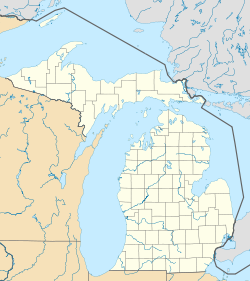world.wikisort.org - USA
Rawsonville is an unincorporated community on the boundary of Washtenaw and Wayne County in the U.S. state of Michigan.[1] The historic community of Rawsonville lies mostly under Belleville Lake, which is an artificial reservoir created in 1925 when the Eastern Michigan Edison Company built the French Landing Dam and Powerhouse along the Huron River.[2]
Rawsonville, Michigan | |
|---|---|
Unincorporated community | |
 Historic marker along Rawsonville Road | |
 Rawsonville Location within the State of Michigan  Rawsonville Location within the United States | |
| Coordinates: 42°12′55″N 83°33′06″W | |
| Country | United States |
| State | Michigan |
| Counties | Washtenaw and Wayne |
| Townships | Van Buren and Ypsilanti |
| Elevation | 709 ft (216 m) |
| Time zone | UTC-5 (Eastern (EST)) |
| • Summer (DST) | UTC-4 (EDT) |
| ZIP code(s) | |
| Area code | 734 |
| GNIS feature ID | 635675[1] |
| Old Rawsonville Village Informational Designation | |
|---|---|
Michigan State Historic Site | |
| Designated | October 27, 1983 |
Rawsonville was dedicated as a Michigan State Historic Site on October 27, 1983.
History
In 1800, the first settler Henry Snow came to this location which was original called Snow's Landing. In 1825, Amariah Rawson and his family arrived at the village.The community plat, as Michigan City by Amariah Rawson and two others, was filed on January 7, 1836. After a group of neighbors petitioned the State Legislature asking that the name be changed to Rawsonville, on March 22, 1839, the act formally changing the name to Rawsonville was passed.[3] On November 14, 1838, The Van Buren post office was moved to Rawsonville and assumed that name.[2]
By the Civil War era, the village was doing well with grist mill, saw mill, a stove factory, and a wagon maker. With the building of the railroad, the community was bypassed hurting the industries there.[4]
On October 25, 1895, the post office was closed. It reopened on November 20, 1895, only to close again on February 28, 1902.[2] By 1900, there were few residents. In 1925, a dam was put in place on the Huron River, placing most of the village under the waters of the new Belleville Lake. The only visual sign that a village was there at one time is the historical marker in front of the McDonald's on Rawsonville Road and across from Grove Road.[4]
References
- U.S. Geological Survey Geographic Names Information System: Rawsonville, Michigan
- Romig, Walter (October 1, 1986) [1973]. Michigan Place Names: The History of the Founding and the Naming of More Than Five Thousand Past and Present Michigan Communities. Great Lakes Books Series (Paperback). Detroit, Michigan: Wayne State University Press. pp. 468, 569. ISBN 081431838X. ISBN 978-0814318386.
- Horste1 Wilson2, Cathy S.1 Diane F.2 (1980). Water Under the Bridge; A History of Van Buren Township; Second Edition. Belleville, Michigan: Van Buren Township Bicentenniall Commission. pp. 169, 171.
- Bingham, Emily (October 26, 2016). "These 11 Michigan ghost towns are eerily intriguing". MLive.com. Mlive Media Group. p. 3. Retrieved October 26, 2016.
Другой контент может иметь иную лицензию. Перед использованием материалов сайта WikiSort.org внимательно изучите правила лицензирования конкретных элементов наполнения сайта.
WikiSort.org - проект по пересортировке и дополнению контента Википедии

